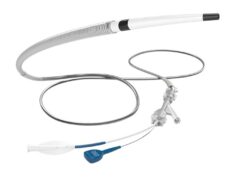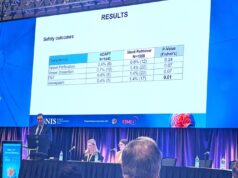 Today, Route 92 Medical has announced positive results from its SUMMIT MAX randomised controlled trial (RCT) comparing the efficacy and safety of the HiPoint reperfusion system, including the super-bore 0.088-inch HiPoint 88 aspiration catheter, to a conventional 0.074-inch catheter. These data were presented at the ongoing European Stroke Organisation Conference (ESOC; 21–23 May, Helsinki, Finland).
Today, Route 92 Medical has announced positive results from its SUMMIT MAX randomised controlled trial (RCT) comparing the efficacy and safety of the HiPoint reperfusion system, including the super-bore 0.088-inch HiPoint 88 aspiration catheter, to a conventional 0.074-inch catheter. These data were presented at the ongoing European Stroke Organisation Conference (ESOC; 21–23 May, Helsinki, Finland).
In addition, the company has announced the receipt of 510(k) NRY clearance from the US Food and Drug Administration (FDA) for its HiPoint reperfusion system, including the HiPoint 88 reperfusion system powered by Tenzing 8 and featuring the Monopoint approach.
Route 92 claims that, with this, it has become the first neurovascular intervention company to receive clearance for direct aspiration of a stroke-causing thrombus with a super-bore 0.088-inch catheter in the neurovasculature.
The SUMMIT MAX RCT demonstrated the superiority of the HiPoint reperfusion system when compared with a conventional 0.074-inch aspiration catheter in achieving its primary efficacy endpoint—revascularisation, with any adjunctive therapy considered a failure.
The trial’s analysis group included 166 study participants, with clinicians successfully delivering the HiPoint 88 aspiration catheter to the stroke-causing occlusion in 89% of cases. In addition, the HiPoint arm of SUMMIT MAX experienced significantly higher revascularisation rates compared to the control arm, and no significant differences were observed between the two study groups for the primary safety endpoint of symptomatic intracranial haemorrhage (sICH).
“The clinical community has long believed that an 0.088-inch super-bore aspiration catheter could improve stroke care by improving first-pass effect [FPE],” said Thanh N Nguyen (Boston University School of Medicine, Boston, USA), co-national principal investigator of the trial along with Ajit Puri (University of Massachusetts Medical Center, Worcester, USA) and Guilherme Dabus (Baptist Health South Florida, Miami, USA). “We require systems of devices capable of improving the quality of reperfusion, reducing procedure times and simplifying the procedure, because time equals brain. Having an FDA-cleared solution backed by the robust data we saw in the SUMMIT MAX clinical trial will go a long way towards advancing stroke care in the USA.”
“These results were similar to the results of the multicentre study Dr Dabus and I conducted in 2022, [from which] results were published in the Journal of NeuroInterventional Surgery,” Puri added. “The high rates of FPE seen in this trial validate our similar findings and show the power of vessel-size-matched aspiration catheters to drive procedural success.”
In addition to the first-time presentation of the SUMMIT MAX trial at ESOC 2025, Route 92 also shared a poster detailing results from participants at the three centres with the largest enrolment in the study. These substudy data demonstrated that centres with more experience using Route 92 products achieved “even more impressive results”, suggesting the potential for better clinical results as these products are widely adopted, the company claims.
In a total of 57 participants included in this substudy, clinicians successfully delivered the HiPoint 88 aspiration catheter to the target M1 segment of the middle cerebral artery (MCA) in 96% of cases, leading to a 96% revascularisation rate. Additionally, rates of FPE were significantly higher in the HiPoint arm versus the conventional arm, as per FPE modified thrombolysis in cerebral infarction (mTICI) ≥2b rates (84% vs 53%, respectively; p=0.02) and FPE mTICI ≥2c rates (68% vs 30%, respectively; p=0.007). Route 92’s recent press release also relays that there were no cases of sICH in the HiPoint arm, while patients in this arm required a significantly reduced usage of adjunctive devices—such as stent retrievers—to achieve revascularisation compared to the control arm (4% vs 53%, respectively; p<0.0001) as well.
“The importance of improving FPE is critical and has been evolving over the past decade,” Dabus commented. “Patients experience better outcomes when we can remove a clot and get blood flowing into all parts of the brain more quickly in one pass. Improvement in FPE to achieve reperfusion of mTICI ≥2c is the goal of procedures today and the SUMMIT MAX results show the potential of the HiPoint 88 reperfusion system as a ‘one-and-done’ workhorse product. We believe having on-label tools with improved FPE rates will enable many more stroke patients to make more complete recoveries.”











